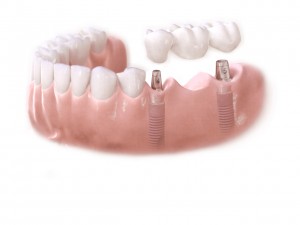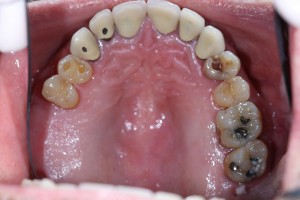MULTIPLE TOOTH DENTAL IMPLANTS

When multiple teeth are missing or failing, treatment options may include:
A removable partial denture
A multiple tooth supported fixed bridge
An implant-supported bridge
A removable partial denture utilizes clasps that grab onto adjacent, healthy teeth to hold the denture in place. The clasps, which are designed to fit snuggly onto the healthy teeth put pressure on the underlying gums and natural teeth they hook onto. This weakens the jawbone and loosens the supporting teeth, which often leads to additional tooth loss. In addition, because there is no root system for the missing teeth, the integrity of the jawbone is compromised, and the melting away of the bone (atrophy) is actually accelerated, resulting in more rapid bone deterioration.
A multiple tooth-supported fixed bridge is a conventional tooth replacement option and has all the complications, compromises and risks of a single tooth bridge, only to a much greater degree. Problems of decay, root canal infections, periodontal bone loss and bone atrophy can be worse simply because there are more teeth involved. Unfortunately, larger bridges fail faster than single tooth bridges.
An implant-supported bridge is far superior to removable partials or multiple tooth supported fixed bridges:
* Dental implants virtually stop the bone resorption process (deterioration)
* Implants are much more comfortable and stable than partial dentures
* The integrity of the facial structure is maintained (no sagging jaw line)
* The gum line stays intact – not eaten away by metal clasps
* Natural biting and chewing capacity is restored
* Adjacent natural teeth are preserved
* You can eat what you want, when you want, where you want – steak, corn on the cob, apples, crunchy snacks, sticky snacks
* Dental implants look, act, and feel just like natural teeth
* Dental implants are permanent – no need to deal with messy adhesives or cleaning solutions
What are the advantages of implant-supported bridges over fixed bridges or removable partial dentures?
Dental implants provide several advantages over other teeth replacement options. In addition to looking and functioning like natural teeth, implant-supported bridges replace teeth without support from adjacent natural teeth. Other common treatments for the loss of several teeth, such as fixed bridges or removable partial dentures, are dependent on support from adjacent teeth.
In addition, because implant-supported bridges will replace some of your tooth roots, your bone is better preserved. With a fixed bridge or removable partial denture, the bone that previously surrounded the tooth root may begin to resorb (deteriorate). Dental implants integrate with your jawbone, helping to keep the bone healthy and intact.
In the long term, implants are esthetic, functional and comfortable. Gums and bone can recede around a fixed bridge or removable partial denture, leaving a visible defect. Resorbed bone beneath bridges or removable partial dentures can lead to a collapsed, unattractive smile. The cement holding bridges in place can wash out, allowing bacteria to decay teeth that anchor the bridge. In addition, removable partial dentures can move around in the mouth and reduce your ability to eat certain foods.

How will the implants be placed?
First, implants, which looks like screws or cylinders, are placed into your jaw. Over the next two to six months, the implants and the bone are allowed to bond together to form anchors. During this time, a temporary teeth replacement option can be worn over the implant sites.
Abutments attached to implants form a foundation for new teethOften, a second step of the procedure is necessary to uncover the implants and attach extensions. These temporary healing caps complete the foundation on which your new teeth will be placed. Your gums will be allowed to heal for a couple of weeks following this procedure.
There are some implant systems (one-stage) that do not require this second step. These systems use an implant which already has the extension piece attached. Your periodontist will advise you on which system is best for you.
Four replacement teeth attached to abutmentsFinally, replacement teeth, or bridges, will be created for you by your dentist and attached to small metal posts, called abutments. After a short time, you will experience restored confidence in your smile and your ability to chew and speak.
Every case is different, and some of these steps can be combined when conditions permit. Your dental professional will work with you to determine the best treatment plan.
